#Tanzania Wet Season
Explore tagged Tumblr posts
Text
Best Time To Visit Tanzania for Wildlife Safari: A Complete Guide
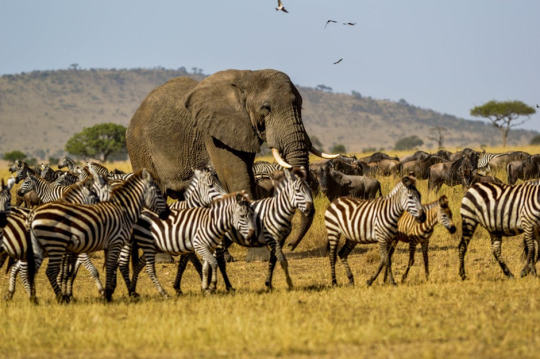
Tanzania, a land of breathtaking landscapes and diverse wildlife, offers a unique adventure year-round. However, choosing the right time to visit can enhance your experience. The Best Time To Visit Tanzania largely depends on your interests and the type of safari or vacation you desire.
For wildlife enthusiasts, the dry season from June to October is ideal. During this period, the animals gather around water sources, making it easier to spot them in the popular national parks like Serengeti and Ngorongoro Crater. The Great Migration, where millions of wildebeest and zebras move across the Serengeti, occurs from June to September.
If you're a bird lover, the Tanzania Wet Season from November to May is the best time to visit. The landscapes are lush, and migratory birds flock to the country. This is also the calving season for wildebeest, providing a different yet equally fascinating wildlife experience.
For those seeking a beach holiday, the Tanzanian coastline, including Zanzibar, is best enjoyed during the dry months from June to October. Crystal-clear waters and sunny days create a perfect tropical paradise.
Keep in mind that prices may vary depending on the season, with the dry season being peak tourist season. However, visiting during the shoulder seasons of March to May and November to mid-December can offer a balance between good weather and fewer crowds.
In conclusion, Tanzania's beauty is timeless, but the Best Time To Visit Tanzania depends on your preferences. Whether you long for wildlife encounters, vibrant birdlife, or a serene beach escape, planning your Tanzania Safari Vacations according to Tanzania's seasonal variations ensures an unforgettable experience.
#Best Time To Visit Tanzania#Ngorongoro Crater#Tanzania Wet Season#Tanzania Safari Vacations#Tanzanian Safari#Serengeti National Park#Tarangire National Park
0 notes
Text
What are the best birding sanctuaries in Tanzania?

Travel Company: DAV Safaris
Website: www.davsafaris.com
Email:[email protected]
Tel: +256757795781 or +256701412430
Tanzania, a breathtaking gem in East Africa, is not only celebrated for its stunning landscapes and vibrant wildlife but also for its remarkable avian diversity. With over 1,100 recorded bird species, this country is a true paradise for birdwatchers. Whether you are a seasoned ornithologist or a casual nature lover, Tanzania offers an array of birding sanctuaries that promise unforgettable experiences. This guide will delve into the best birding sanctuaries in Tanzania, highlighting key locations, notable species, and essential tips for your Tanzania birding tours.
1. Serengeti National Park
Serengeti National Park is arguably the most famous wildlife reserve in the world. While known for the Great Migration, its diverse birdlife is equally captivating. The park hosts over 500 bird species, making it a premier destination for birding enthusiasts.
In the Serengeti, birdwatchers can expect to see the elegant Secretary Bird, the majestic African Fish Eagle, and various species of vultures and raptors. The park’s varied habitats, ranging from open savannas to lush riverine forests, provide a rich tapestry for bird watching.
Birding is excellent year-round, but the wet season (November to April) is particularly rewarding. During this time, migratory species flock to the area, enhancing your bird watching experience.
2. Ngorongoro Crater
A UNESCO World Heritage site, the Ngorongoro Crater is a unique ecosystem that supports a diverse range of wildlife and bird species. Its stunning landscapes create an unforgettable backdrop for bird watching.
The crater is home to the rare Black Rhinoceros and over 200 bird species, including the impressive Lammergeier and the striking Kori Bustard. The mix of habitats—from expansive grasslands to dense woodlands—greatly enhances the birding experience.
The dry season (June to October) offers optimal visibility for wildlife, including birds. This period is ideal for spotting both resident and migratory species.
3. Lake Manyara National Park
Lake Manyara is renowned for its diverse ecosystems, including wetlands, forests, and grasslands. This park is a birdwatcher’s dream, with over 400 bird species recorded.
Birdwatchers can spot the iconic Flamingos, the colorful African Jacana, and the striking Grey-headed Kingfisher. The park is also known for its large populations of pelicans and storks, making it a birding hotspot.
The wet season attracts migratory birds, while the dry season provides excellent opportunities to see resident species. Thus, it’s a prime destination throughout the year.
4. Tarangire National Park
Tarangire is known for its iconic baobab trees and large herds of elephants. This hidden gem offers incredible bird watching opportunities, thanks to its diverse habitats.
Key Species
Look for the Tawny Eagle, the African Pygmy Goose, and the vibrant Yellow-collared Lovebird. Tarangire is also home to many migratory species during the wet season, enhancing the bird watching experience.
The best months for bird watching are during the wet season (November to April) when migratory birds arrive, providing a spectacular display for birdwatchers.
5. Ruaha National Park
As Tanzania's largest national park, Ruaha offers a unique mix of savanna and bushland, providing an excellent birding experience. Its remote location means fewer tourists, allowing for a more intimate bird watching adventure.
Ruaha is home to over 570 bird species, including the striking African Harrier-Hawk and the colorful Lilac-breasted Roller. The diversity of habitats supports a wide range of birdlife, making each visit unique.
The dry season (June to October) is ideal for spotting wildlife, including birds, as they become more active and visible.
6. Lake Victoria
As the largest lake in Africa, Lake Victoria supports a rich variety of bird species. The lake's wetlands and shores create perfect conditions for bird watching.
Look for the African Fish Eagle, Papyrus Gonolek, and various heron species. The lake is crucial for migratory birds, making it a hotspot during specific times of the year.
The wet season (November to April) attracts many migratory species, enhancing bird watching opportunities and making it a prime location during this period.
7. Amani Nature Reserve
Located in the Usambara Mountains, Amani Nature Reserve is a lesser-known sanctuary that offers a unique birding experience. The lush rainforest and diverse habitats provide a haven for many bird species.
Birdwatchers can look for the endemic Usambara Thrush and the vibrant Amani Sunbird, along with numerous other forest birds. This reserve plays a critical role in bird conservation in Tanzania.
Birding is excellent year-round, but the dry season offers the best opportunities for spotting endemic species, making it a must-visit for dedicated birdwatchers.
8. Usambara Mountains
The Usambara Mountains are characterized by a range of ecosystems, from montane forests to grasslands. This area is rich in biodiversity, making it a fantastic location for birding.
The mountains host several endemic species, including the Uluguru Bushshrike and the Tanzania Mountain Greenbul. The lush vegetation supports a variety of other birds, providing numerous bird watching opportunities.
The dry season (June to October) is best for bird watching, as birds are more active and visible, allowing for better sightings.
c provide an incredible opportunity to explore the country’s rich avian biodiversity. From the iconic Serengeti to the serene Amani Nature Reserve, each location offers unique bird watching experiences. Whether you're embarking on Tanzania birding tours or exploring these stunning sanctuaries independently, you’re sure to create unforgettable memories. Prepare your binoculars, pack your camera, and get ready to witness the incredible birdlife that Tanzania has to offer!
Book with DAV Safaris on www.dasafaris.com or our expert team directly
#What are the best birding sanctuaries in Tanzania?#Travel Company: DAV Safaris#Website: www.davsafaris.com#Email:[email protected]#Tel: +256757795781 or +256701412430#Tanzania#a breathtaking gem in East Africa#is not only celebrated for its stunning landscapes and vibrant wildlife but also for its remarkable avian diversity. With over 1#100 recorded bird species#this country is a true paradise for birdwatchers. Whether you are a seasoned ornithologist or a casual nature lover#Tanzania offers an array of birding sanctuaries that promise unforgettable experiences. This guide will delve into the best birding sanctua#highlighting key locations#notable species#and essential tips for your Tanzania birding tours.#1. Serengeti National Park#Serengeti National Park is arguably the most famous wildlife reserve in the world. While known for the Great Migration#its diverse birdlife is equally captivating. The park hosts over 500 bird species#making it a premier destination for birding enthusiasts.#In the Serengeti#birdwatchers can expect to see the elegant Secretary Bird#the majestic African Fish Eagle#and various species of vultures and raptors. The park’s varied habitats#ranging from open savannas to lush riverine forests#provide a rich tapestry for bird watching.#Birding is excellent year-round#but the wet season (November to April) is particularly rewarding. During this time#migratory species flock to the area#enhancing your bird watching experience.#2. Ngorongoro Crater#A UNESCO World Heritage site
0 notes
Text
Manyara Ranch: African Wildlife Foundation
Good story from the African Wildlife Federation. Tap/click on the caption to get to the PDF version of the report.

Excerpt:
A long time ago, the people of Tanzania and their livestock adopted to living alongside wildlife. For millennia, the Maasai have tracked the movements of wildebeests to identify good grazing; the favorite hideouts of lions to avoid attacks on cattle; and the presence of oxpeckers to know if dangerous buffalo are nearby.
In the past 60 years, however, drastic changes have come to the Maasai Steppe, a large semi-arid grassland ecosystem in north-central Tanzania. Large-scale farms, the expansion of safari tourism, the creation of national parks, and restricted access to once communally used land have squeezed the rangeland available to livestock. With more cattle on less land, grasslands are becoming overgrazed. The spread of human settlements and agriculture have blocked age-old wildlife migration routes, leading to more frequent—and sometimes deadly—confrontations between people and animals. And climate change, which has intensified droughts and upended rainfall patterns, is escalating competition for green grass and fresh water, pushing even more pastoralists to agriculture.
Anchoring the Maasai Steppe are Tarangire and Lake Manyara National Parks, where the shores of the eponymous river and lake abound with wildlife in the dry season. The steppe is home to some of the world’s most abundant and diverse wildlife, including one of the largest—and growing– populations of elephants in Africa (recovering from heavy poaching in the 1970s and 1980s) and the only stronghold of the eastern white-bearded wildebeests. The ability to move between the parks and beyond them into the plains is crucial for the survival of many of the ecosystem’s most iconic species, including elephants and wildebeests. But safe, unimpeded pathways are becoming scarce. In between the two parks, in the all-important Kwakuchinja wildlife corridor, sits a patchwork of villages, farms, large herds of livestock, grasslands—and Manyara Ranch.
Since 2001, the African Wildlife Foundation (AWF) has championed a unique conservation model for the ranch, starting with negotiations with the government to form a land conservation trust to make the ranch a conservation space. Beginning in 2013, we took over direct management of the ranch, balancing the working cattle ranch with habitat restoration and wildlife conservation—a new model for Tanzania.While Tanzania’s pastoralists generally are prohibited from bringing livestock into national parks, cattle are a nonnegotiable part of the region’s economy and culture. Therefore, successful conservation of land outside formal protected areas depends on the sustainable coexistence of livestock and wildlife, particularly along migration routes where wildlife move outside of the boundaries of the parks. Manyara Ranch is a vital link along one of those migration routes. It helps connect the national parks to each other and to the wet-season grazing grounds of the Northern Plains, described as the “last, best remaining breeding ground” for the ecosystem’s migrating wildebeest, zebras, gazelles, and others. In addition to the migrating animals that seasonally pass through, the ranch today is home to resident giraffes, lions, and many other iconic African species—as well as more than a thousand cattle.
The lease to the land is now held by the Monduli District Council, and the day-to-day running of the ranch is managed by the Manyara Ranch Management Trust, composed of representatives from the Monduli council, two local villages, the Tanzania Wildlife Management Authority, and AWF.
“The vision for a project like this is to bring management expertise to the local stakeholders. We want to think inclusively and really focus on creating local partnership in decision-making regarding operations,” said Pastor Magingi, AWF’s Tanzania Country Coordinator.
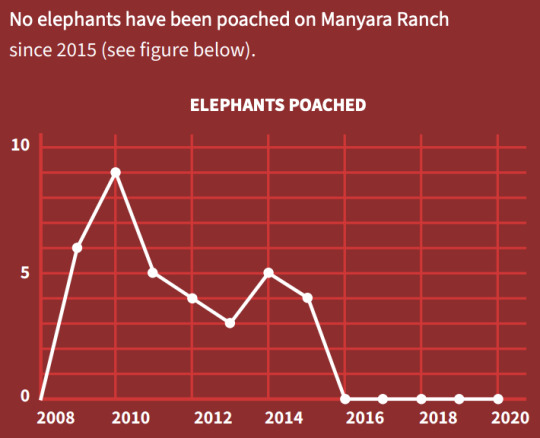

3 notes
·
View notes
Text
Cheetah
AKA: spotted one (indian original name)
Acinonyx jubatus
Felidae family, acinonyx genus

Ultimate Infodump Sheet
General description
Cheetahs have pale yellow, grayish or fawn coats, covered in tiny black spots. The belly fur is lighter than the rest, while the color tends to darken on the back. Cheetahs have distinctive markins under the eyes that go down the muzzle, called a tear mask. They have black rings around the last third of the tail.
The cheetah's paws are long and narrow. They have semi-retractile claws on the front paws, and non-retractile claws on the hind paws.
Cheetahs' head-body length ranges from 112 to 150 cm (44 to 59"), and they are 67 to 94 cm (26 to 37") tall at the shoulder. Cheetahs weight between 21 and 72 kg (46 to 158 lbs). Males are usually larger than females.
They live 6 years on average in the wild, and 19 in captivity.
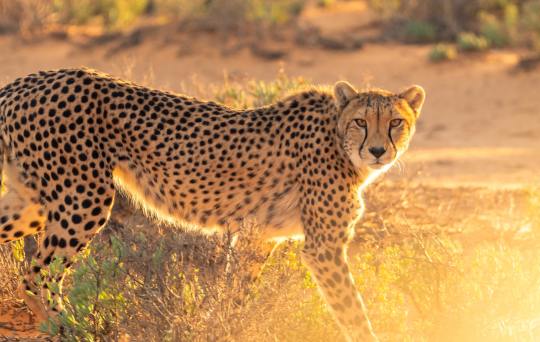

King cheetahs
The patterns of a king cheetah are caused by a slight melanism. Overall, the spots are bolder, sometimes even forming stripes. They have large stripes along the entierty of thair back, and rings are present on most of the tail.

Physical aptitudes
Cheetahs are the fastest land animal. The highest speed recorded for a cheetah was 113 km/h (70 mi/h). They are the only big cat able to turn in the air while sprinting. They use their tail for steering while they are running. They are bad tree climbers.
Contrary to members of the panthera genus, they do not roar: instead, cheetahs can purr, meow, chirp and yeep.
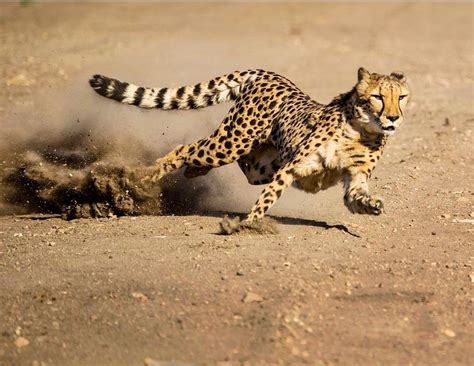
Habitat
Cheetahs live in savanna, shrublands, grasslands, wetalands, rocky areas, and in the desert. Due to their light weight, they are capable of living in dunes.
Cheetahs present in several small areas of Africa, in countries such as Algeria, Angola, Benin, Ethiopia, Tanzania, Uganda... They are extint on an alarmingly large portion of Africa.

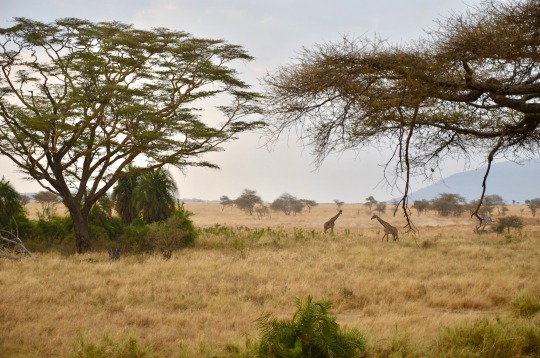
Diet
Cheetahs are carnivorous. Their diet includes gazelles (especially the Thompson's gazelle), impalas, as well as other small ungulates. They also prey on hares, birds, and other small animals.
Cheetahs charge from 70 to 100 meters (27 to 40 feet) away from the prey. They strangle the animal with their jaws. The chase can only last 500 meters (196 feet), and cheetahs can only maintain their top velocity for a few hundred meters.
Contrary to most felids, cheetahs are diurnal and hunt primarily during the day.
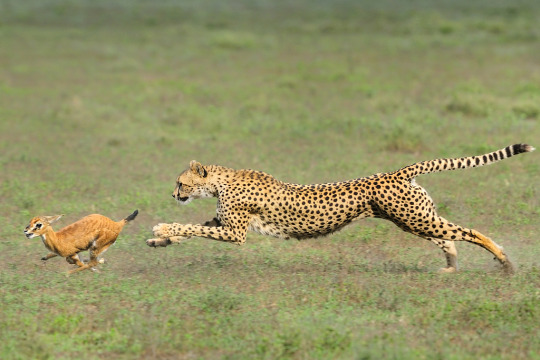
Reproduction
Cheetahs reproduce year-long, but mostly during wet season. Makes provide no parental care, and only interact with females during mating. If the female encounters a coalition, she will most likely reproduce with several males.
Gestation lasts between 90 and 95 days (about 3 months). Cubs open their eyes 4 to 11 days after birth, and start walking after 12 days. The litter size in the wild is 1 to 6 cubs, with an average of 3. In captivity, litters with 8 cubs have been recorded. Cubs are weaned between 3 and 6 months, and become independent between 15 and 17 months.
Cheetah cubs have a long, blue-ish gray mane along their head, neck and back, called "mantle". They gradually lose this fur until they reach adolescence. A study suggests that the mantle makes cubs ressemble honey badgers, which aids them to survive as a lot of animals avoid honey badgers.
Predation is the highest on cheetah cubs. The survival rate in Serengeti National Park, where several large carnivores live, is of only 17%.

Endangered
Cheetahs are classified as vulnerable in the IUCN Redlist. The population is fragmented and keeps on decreasing.
The causes are all human: climate change, energy production and mining, urban development, agriculture, roads, hunting, human intrusion, modification of natural systems, invasive species....

Extra links
An interesting, well illustrated informational website that I wish I'd found earlier in writing this
Amazing footage of a cheetah hunting a wildebeest
SOURCES
9 notes
·
View notes
Text
how to prepare for the climb
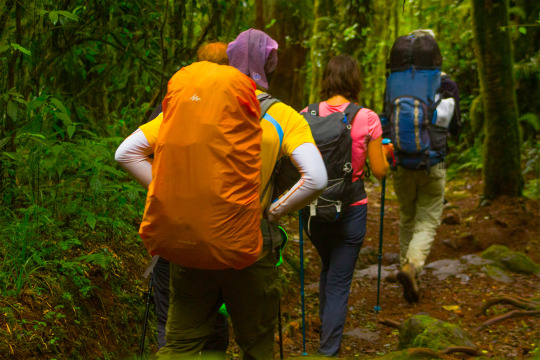
First of all I want to make clear that we are talking about a pretty high mountain. As you know the weather in the mountains is very hard to predict and can often change very quick. In fact the temperature on the summit of Kili is usually below freezing, which means that you can face temperatures of -20°C on Uhuru Peak while having about +30°C down in Moshi. No matter which time of the year: you should always come well prepared. There are different seasons in Tanzania but not like the winter & summer season as we know it from Europe or North America. Due to its proximity to the Equator the year is divided into wet and dry season. Therefore the best time to climb Kilimanjaro is during the dry season between August and October as rainfall during that time is at its lowest and you have the highest chance of having clear views to and from the mountain. On the flip side said months are also the high season on the mountain which means it is also the busiest time of the year (by choosing a longer, less popular route it'll be more relaxed!).
2 notes
·
View notes
Text
Tanzania Dry Season – When is the Best Time for Safari Experience

Tanzania's stunning landscapes and rich wildlife make it a dream destination for safari enthusiasts. To experience the Great Migration in the Serengeti, explore the Ngorongoro Crater, or encounter elephants in Tarangire, it's essential to know the Best Time to Visit Tanzania for perfect weather and exceptional wildlife viewing.
The Dry Season is considered the best time for a Tanzania Safari Experience, offering clear skies and excellent wildlife sightings.
Planning your Tanzania Safari Tour during the right season will help you make the most of your adventure in its stunning national parks.
Why Choose the Dry Season?
The dry season is the best time to explore the country’s incredible landscapes and diverse wildlife. With clear skies and open plains, this period provides the perfect setting for game drives and Wildebeest Migration in Serengeti, photography, and unforgettable encounters with Africa’s most iconic animals.
Better Wildlife Viewing: Animals congregate around water sources, making them easier to find.
Clear Skies: The weather is sunny and dry, providing ideal conditions for photography and outdoor activities.
Accessible National Parks: Most national parks are easier to navigate with fewer roadblocks.
Optimal Game Viewing: The vegetation is less dense, giving you better visibility to spot wildlife.
Perfect for a Tanzania Safari Tour: The dry season is the perfect time for safaris, offering an unforgettable Tanzania safari experience.
During the dry season, a Tanzania Safari offers stunning views, lots of wildlife, and the best chance to see nature at work. This is the best time for a journey, whether you want to see lions in the Serengeti or elephants in Tarangire.
The Best Time to Visit Tanzania depends on what you want to experience. For Tanzania Safari Tours, the dry season (June–October) offers incredible wildlife sightings, while the wet season (November–May) brings lush landscapes and fewer crowds. No matter when you visit, Sumbi Extra Miles Safari ensures a seamless adventure.
Want to know more details, visit this blog @ https://sumbiextramilessafari.com/blog/tanzania-dry-season-when-to-go-for-the-best-safari-experience/
0 notes
Text
When to Visit Africa: Discover the Best Time for Your Adventure
Africa offers an array of unique experiences that change with the seasons, making it essential to choose the right time for your adventure. The continent’s diverse climates and landscapes provide the perfect backdrop for outdoor exploration, wildlife safaris, and cultural encounters. From the vibrant dry season, ideal for game viewing, to the lush wet season, offering a different perspective of Africa’s natural beauty, understanding when to visit can help you tailor your journey to the experiences you most desire. Whether you’re seeking thrilling safaris, peaceful hikes, or vibrant cultural festivals, selecting the optimal season can transform your adventure.
#cheetah safaris#luxury tanzania safaris#african luxury safaris#african safaris#luxury kenya safaris#kenya luxury safaris#When to Visit Africa
0 notes
Text
Crafting the Perfect 7 Days Tanzania Cultural Safari Adventure
When you think of Tanzania, endless savannahs and incredible wildlife might come to mind, but the cultural richness of this East African country is just as extraordinary. A 7 Days Tanzania Cultural Safari offers an immersive journey where ancient traditions, vibrant communities, and breathtaking landscapes converge. This guide will show you how to plan a culturally rich safari experience that goes beyond the game drives.
Discover Wildlife and Culture at Lake Manyara National Park
Your cultural safari begins at Lake Manyara National Park, a scenic destination renowned for its wildlife and unique landscape. Famous for its tree-climbing lions, abundant birdlife, and beautiful lakeshores, Lake Manyara is also where you can see elephants, zebras, and giraffes in their natural habitat. This is more than a wildlife experience—it's an introduction to the symbiotic relationship between Tanzania’s communities and nature.
Ngorongoro Crater: A Fusion of Culture and Natural Wonder
Next, head to the Ngorongoro Crater, a UNESCO World Heritage Site and an awe-inspiring natural feature. This vast caldera is home to a diverse array of wildlife, including the iconic Big Five. But the area is also deeply connected to Tanzania’s cultural history, especially with the Maasai people, who still live in the region and maintain their traditional way of life. A visit to the Ngorongoro Crater not only offers thrilling wildlife sightings but also insights into the cultural significance of this land.

Meet Tanzania’s Indigenous Communities
An essential part of the 7 Days Tanzania Cultural Safari is meeting the local tribes, who offer a window into Tanzania’s unique cultural mosaic.
Hadzabe Tribe: Near Lake Eyasi, you’ll encounter the Hadzabe people, one of the last hunter-gatherer tribes in the world. Their way of life, unchanged for centuries, provides an authentic and rare cultural experience. Join them on a hunting expedition to understand their deep connection with nature.
Mto wa Mbu Village: This village, where over 120 ethnic groups reside, is a vibrant example of Tanzania’s cultural diversity. Stroll through local markets, sample traditional dishes like ugali and nyama choma, and engage with the local artisans as they craft intricate pieces of art and souvenirs.
Maasai People: No cultural tour is complete without a visit to a Maasai village. Known for their colorful attire and rich traditions, the Maasai invite you to participate in their daily activities, from traditional dances to learning about their ancient customs and their relationship with the land.
Cultural Treasures Beyond Wildlife
Your cultural safari offers much more than animal sightings. It’s a chance to delve into the daily lives of Tanzanian people and appreciate their traditions.
Local Cuisine: Tanzanian food is a reflection of the country’s agricultural roots. Savor local dishes like mishikaki (grilled skewers), nyama choma (grilled meat), and ugali, a staple made from maize flour. Each dish tells the story of the land and its people.
Music and Dance: Tanzanian culture is infused with vibrant music and dance. Whether it’s the rhythmic beat of the drums or the energetic traditional dances, the country’s music scene is an essential cultural experience you shouldn't miss.
Arts and Crafts: Tanzanian artisans are known for their skilled craftsmanship. From Maasai beadwork to intricate wood carvings, you’ll find stunning, hand-made pieces that reflect the culture and history of the people.

Essential Tips for Planning Your Cultural Safari
Choose a Reliable Tour Operator: Selecting a reputable tour operator like Chalema Tanzania Safaris ensures you experience the best of the 7 Days Tanzania Cultural Safari with a balance of wildlife and cultural exploration.
Travel During the Best Season: The dry season (June to October) is ideal for wildlife viewing, while the wet season (November to May) offers lush landscapes and fewer tourists. Choose your travel dates based on the experience you seek.
Pack for Comfort and Respect: Be sure to pack comfortable clothing, durable shoes, sunscreen, and a hat. Respect local customs by dressing modestly, especially when visiting villages and cultural sites.
Conclusion
A 7 Days Tanzania Cultural Safari allows you to go beyond the usual safari experience. From breathtaking wildlife encounters to meaningful cultural exchanges, this journey will leave you with a deep connection to Tanzania’s people and landscapes. Ready for the adventure of a lifetime? Book your trip with Chalema Tanzania Safaris and immerse yourself in the heart of Tanzanian culture.
For more Information about our citation please visit our citation links:-businesssoftwarehelp.com, mylifegb.com, about.me, bizidex.com, clutch.co
0 notes
Text
Tanzania Safari Trips: The Ultimate Adventure for Nature Lovers

For nature lovers, a Tanzania safari trip offers a once-in-a-lifetime adventure. From the vast savannahs of the Serengeti to the spectacular heights of Mount Kilimanjaro, Tanzania is home to some of the world’s most breathtaking natural landscapes and wildlife. Whether you’re on your first safari or a seasoned traveler, this East African destination promises unforgettable moments for those with a passion for the natural world.

Immerse Yourself in Tanzania’s Untouched Beauty
Tanzania's diverse ecosystems and stunning landscapes are one of its main attractions. The Serengeti National Park, famous for the Great Migration, offers one of the best safari experiences in Africa. This awe-inspiring migration involves over a million wildebeests, zebras, and gazelles as they journey across the plains, with predators like lions and cheetahs in pursuit. The Serengeti’s endless horizon of golden grasslands is a haven for those who seek to witness raw nature.
Another must-visit destination is the Ngorongoro Crater, a UNESCO World Heritage Site and the world’s largest inactive volcanic caldera. The crater floor is teeming with wildlife, including elephants, lions, and the critically endangered black rhino. Standing at the rim of the crater and observing the stunning panoramic views is an experience that can’t be matched.

Thriving Wildlife in Tanzania
Tanzania’s rich biodiversity is the reason why it’s a dream destination for wildlife enthusiasts. The country is home to the famed Big Five, as well as over 1,100 bird species, countless herbivores, and elusive predators. For the best safari tours in Tanzania, the Serengeti and Ngorongoro are unbeatable, but parks like Tarangire and Lake Manyara also provide incredible wildlife viewing opportunities. Tarangire is known for its massive elephant populations, while Lake Manyara is famous for its tree-climbing lions and diverse bird species.
Beyond the safari experience, Tanzania also offers opportunities to hike the world-renowned Mount Kilimanjaro or trek through the lush rainforests of the Mahale Mountains, home to wild chimpanzees.

A Safari for Every Season
Timing is key when planning your safari trip. The dry season from June to October is considered the best for wildlife viewing, while the wet season from November to May is ideal for birdwatching and seeing newborn animals. The Great Migration typically peaks between July and September, when animals cross the Mara River, providing an extraordinary spectacle for visitors.

Tanzania Awaits the Adventurer in You
For those craving more than wildlife viewing, Tanzania offers incredible experiences such as trekking, cultural tours, and stunning coastal escapes. You can explore nearby Zanzibar’s pristine beaches or engage with local Maasai communities to gain insight into their culture and traditions.
Whether you seek adventure, discovery, or a peaceful retreat into nature, Tanzania has it all. At KIBOKO SAFARIS, we specialize in organizing the best safari tours in Tanzania and the surrounding areas, such as Arusha and Moshi. To book your dream safari trip, reach out to us today.
Phone: +1 (317) 438-4412 Email: [email protected]
#TanzaniaSafari#NatureLoversParadise#UltimateAdventure#WildlifeSafari#ExploreTanzania#SafariAdventure#AfricaSafariTrips
0 notes
Text
Dry Season Or Wet Season- Which Is Better For Tanzania Safaris

Tanzania, with its diverse wildlife and stunning landscapes, is a dream destination for wildlife enthusiasts and adventure seekers. But when is the Best Time To Visit Tanzania?
The answer depends on whether you prefer the dry season or the wet season when choosing the best Tanzania Safari Packages. In this blog, we'll explore the advantages and considerations of both seasons to help you decide which is better for your safari experience.
Dry Season in Tanzania: June to October
youtube
The dry season, spanning from June to October, is often considered the Best Time Of The Year To Visit Tanzania due to several advantages.
Pros of the Dry Season:
Optimal Wildlife Viewing: During this period, the wildlife congregates around water sources, making it easier to spot Tanzania Wildlife.
Mild Weather: The dry season offers pleasant, cooler temperatures, which are more comfortable for outdoor Activities In Tanzania.
Less Mosquitoes: Fewer insects mean a lower risk of contracting mosquito-borne diseases like malaria.
Peak Season for Safaris: Many tourists prefer the dry season, so it's a great time to meet like-minded travelers and share your experiences.
Cons of the Dry Season:
Crowds: While the dry season is popular for Safaris In Tanzania, it also means more tourists, leading to busier national parks and accommodations. So, booking in advance is advisable.
Higher Costs: Due to the higher demand, prices for Tanzania Accommodations and tours are usually higher during the dry season.
Dry Landscapes: The once lush landscapes become parched, which may not be as visually appealing to some visitors.
The Wet Season in Tanzania: November to April
The wet season in Tanzania spans from November to April, and it offers a different, yet rewarding safari experience:
Pros of the Wet Season:
Green and Lush Landscapes: The rains bring life to the savannah, turning it into a green paradise. It's a fantastic time for photographers as landscapes burst with vibrant colors.
Baby Animals: The wet season is the calving season for many animals, including wildebeest and zebras. This means the chance to witness adorable baby animals taking their first steps.
Lower Tourist Numbers: Compared to the dry season, the Wet Season In Tanzania sees fewer tourists, allowing for a more tranquil safari experience.
Reduced Prices: Tanzania Holiday Packages are often more budget-friendly during the wet season.
Cons of the Wet Season:
Muddy and Unpredictable Roads: The rains make roads within the Tanzania National Parks and reserves muddy and less accessible. Game drives might be limited to well-maintained tracks.
Insect Activity: The wet season sees an increase in insect activity, including mosquitoes. It's essential to take precautions against malaria and insect bites.
Intermittent Rainfall: While the wet season offers lush landscapes, it also means sporadic rainfall, which can affect the timing and enjoyment of your safari activities.
Tips for Choosing the Right Season
To help you make an informed decision, here are some tips for choosing between the dry and wet seasons for your Tanzania safari:
If You Prefer the Dry Season:
Book your Tanzania Tours And Packages well in advance to secure your spot.
Be prepared for larger crowds and higher prices.
Pack light, breathable clothing and sunscreen to protect yourself from the sun.
If You Prefer the Wet Season:
Embrace the beauty of the lush landscapes and be patient when it comes to wildlife spotting.
Consider taking a birdwatching tour to make the most of the migratory species' presence.
Plan for potential rain delays and pack waterproof gear and an umbrella.
Tanzania's Safari Magic: Dry or Wet, It's Fantastic!
In a nutshell, choosing the Best Time To Visit Tanzania between the dry and wet seasons ultimately depends on your preferences and priorities. The dry season offers optimal wildlife viewing and mild weather but comes with crowds and higher costs. On the other hand, the wet season provides lush landscapes, fewer tourists, and lower costs but can be challenging for wildlife spotting.
Whichever season you choose, Tanzania promises a unique and unforgettable safari experience, rich in natural beauty and diverse wildlife. So, consider your priorities while planning your Tanzania Safari Packages, no matter what the season is.
0 notes
Text
Best Safari Destinations in Tanzania are Really Going to Amaze You!
A tour is mainly a planned trip where people visit different places and see new things. Tours can be short that last just a few hours or long that last several days or even weeks. They can be taken alone, with family or even with friends. There are many types of tours and each one offers something unique. Going on a nature tour can be the best way to relax. A tour can help people in many ways making travel easier, more educational and also more enjoyable. When you book a tour the tour company takes care of all the details. They plan the itinerary, arrange transportation, plan activities and also book the accommodations.

This cost will surely not hamper your traveling budget
Western Tanzania safari tour cost is affordable. A safari tour in Western Tanzania is a wonderful way to see amazing wildlife and also the beautiful landscapes. The place is less visited than other parts of the country that makes it a great choice for those who want a more private and special experience. The best time to visit Western Tanzania is during the dry season which is from June to October. This is when the weather is most enjoyable and also the wildlife is easier to spot because animals gather around water sources. The wet season is from November to May which can also be good but it may be harder to see some animals and some roads can be very difficult to find.
Visit more places
Best safari destinations in Tanzania have beautiful landscapes, many national parks and also amazing wildlife. The Serengeti is famous for its huge plains and large numbers of animals. It is best known for the Great Migration where millions of wildebeests, gazelles and zebras move in search of fresh grass and water. Tarangire is known for its large herds of elephants and also for its giant baobab trees. There are also more places to visit that offer one of the best experiences.
#Best Safari Destinations In Tanzania#Bird Watching Safari Tanzania#Tanzania Honeymoon Safari Packages
0 notes
Text
Discover the beauties of a Serengeti Safari Tour
For those seeking an intense adventure, the Serengeti—a name associated with the enormous African wilderness—offers an unparalleled encounter. Situated in Tanzania, this well-known national park has wide plains, many wildlife, and a distinctive scenery that draws tourists from all across the world who enjoy the natural surroundings. A Serengeti safari is a totally submerged experience in one of the most unique settings on Earth, not just a trip.
The unique, attractive value of the Serengeti
The Serengeti's tremendous diversity and the well-known tremendous Migration—where millions of wildebeests, zebras, and gazelles roam the plains in search of better ground—define its attractiveness. Said to be one of the most fantastic animal events on Earth, this natural show offers a great viewing platform. Beyond the Migration, the Serengeti is a popular spot for lovers and photographers of animals as it features the Big Five: lion, elephant, buffalo, leopard, and rhinoceros.
Plan Your Serengeti Safari Trip
Starting a Serengeti safari tour requires meticulous planning to provide a unique and instructive experience. The animal events you want to view will decide the best time to visit. For instance, the Great Migration happens many times a year as the herds circle Kenya's Serengeti and neighboring Masai Mara. Regarding game viewing, the dry season—from June to October—is ideal; the wet season, from November to May, offers lush landscapes and many animals.
When you book your safari, consider the style of accommodation that most suits your preferences. From luxurious hotels to mobile tented camps, the Serengeti offers a range of options to help you choose a site that enhances your nature experience. Every kind of accommodation provides several perspectives of the landscape and its inhabitants.
What Should One Expect from a Safari Tour in Serengeti?
A safari in Serengeti assures interactions with some of the most amazing animals in their natural habitat. Since morning and evening game drives are the times when animals are most active, they often mark the highlights of the day. Knowledgeable guides will lead you over the park while teaching about the ecosystems and fauna. Every safari is different because of the grandeur of the Serengeti; everyday views and sensations also change.
Apart from game drives, consider experiencing the Serengeti from another angle via a hot air balloon excursion at dawn. This unusual meeting offers a bird's-eye view over the plains, therefore changing your perspective on the landscape and its inhabitants.
Conclusion:
A safari in Serengeti is an adventure you will always have with you rather than simply a trip. From the fantastic Great Migration to the delight of sighting the Big Five, every encounter is stunning. While you are planning yours, trust experts like vivaafricatours.com to provide a perfect and fantastic safari experience. Beginning your Serengeti safari adventure will assist you in discovering the magic of the most famous national park in Africa.
0 notes
Link
1 note
·
View note
Text
Your Complete Tanzania Travel Guide - Gateway to Adventure

Tanzania stands out as one of Africa's most captivating travel destinations, celebrated for its stunning landscapes, diverse wildlife, and rich cultural heritage. Whether you're a seasoned traveler or embarking on your first adventure, a Safari In Tanzania offers a once-in-a-lifetime opportunity to elevate your journey to extraordinary heights. With our comprehensive Tanzania Travel Guide, you can plan the perfect trip and ensure your Safari Tour in Tanzania becomes an unforgettable adventure.
Best Time to Visit Tanzania:
The Best Time to Visit Tanzania for safari largely depends on the type of wildlife experience you want. Generally, the dry season from June to October is regarded as the best time to go to Tanzania for safaris. During this period, the animals gather around waterholes, making them easier to spot, and the weather is cooler and dry, ideal for game viewing.
If you’re keen on witnessing the Great Wildebeest Migration, the best times to visit Tanzania are from July to September, when the migration crosses the Mara River. However, for those looking to avoid the crowds, the wet season (November to May) offers a lush, green landscape and fewer tourists.
The Sumbi Extra Miles Safari is your trusted partner for an authentic and personalized safari in Tanzania. We provide tailor-made itineraries, expert guides, and luxurious accommodations to ensure you get the Best Tanzania Safari Experience.
Our speciality is creating heartfelt and experienced Tanzania Safaris that will never be forgotten. Our staff is committed to providing safaris that allow you to engage with both culture and the natural world.
Every Safari in Tanzania is carefully planned to ensure a smooth journey, from famous wildlife encounters to engrossing cultural activities. We guarantee that every excursion gets you closer to Tanzania’s distinct beauty with knowledgeable Tanzania Travel Guide and individualized attention.
Come discover Tanzania’s treasures with us, from stunning scenery to abundant wildlife, all while being comfortable and well-cared for.
0 notes
Text
Why Lake Manyara is Known for its Diverse Birdlife
Nestled in the heart of Tanzania’s Great Rift Valley, Lake Manyara National Park stands out as a haven for birdwatchers and nature enthusiasts alike. With over 400 bird species recorded within its boundaries, Lake Manyara boasts a rich and diverse avian population that thrives in its varied habitats. From majestic raptors to colorful waterfowl, here’s why Lake Manyara is renowned for its exceptional birdlife:
1. Prime Location Along Migratory Routes
Lake Manyara’s strategic location along major migratory routes makes it a vital stopover for countless bird species traversing Africa. During the wet season, the lake’s shallow waters teem with migrating birds, including flamingos, pelicans, and storks, as they rest and feed on algae and aquatic insects. This annual migration transforms Lake Manyara into a vibrant hub of avian activity, attracting birdwatchers from around the world.

2. Diverse Habitats and Ecosystems
Lake Manyara National Park’s diverse habitats—from dense forests and woodlands to open savannahs, marshes, and the lake itself—provide a variety of ecosystems that support a wide range of bird species. Each habitat offers unique resources and niches for different birds, contributing to the park’s exceptional biodiversity.

3. Abundance of Water Sources
The presence of Lake Manyara and its surrounding wetlands ensures a constant and reliable water source throughout the year. These water bodies attract a plethora of waterfowl, including herons, egrets, ibises, and ducks, which thrive in the park’s aquatic environments. The abundance of water supports a rich food chain, sustaining diverse bird species and facilitating breeding activities.

4. Specialized Adaptations and Behaviors
Birds at Lake Manyara exhibit specialized adaptations and behaviors that contribute to their diversity and survival in the park’s varied landscapes. From fish eagles that soar above the lake in search of prey to kingfishers that dive into water for fish, each species has evolved unique skills and characteristics suited to their ecological niche within Lake Manyara’s ecosystem.
5. Year-Round Bird Watching Opportunities
Whether you visit during the dry season, when resident bird species are active, or the wet season, when migratory birds arrive in large numbers, Lake Manyara offers year-round bird watching opportunities. Guided birdwatching tours and nature walks allow visitors to explore the park’s birding hotspots, observe behavior patterns, and learn about the importance of avian conservation.

6. Conservation Efforts and Sustainability
Lake Manyara National Park is committed to conservation and sustainable tourism practices that protect its diverse birdlife and natural habitats. By supporting responsible tourism initiatives and wildlife conservation efforts, visitors contribute to the preservation of Lake Manyara’s avian wonders for future generations to enjoy.
Planning Your Birdwatching Adventure
When planning your visit to Lake Manyara, consider the best time of year for birdwatching based on migratory patterns and local climate conditions. Choose from a variety of safari tours, guided birdwatching expeditions, and eco-friendly accommodations that offer immersive experiences amidst Tanzania’s avian paradise.
Conclusion
Lake Manyara National Park’s reputation for diverse birdlife is well-deserved, offering birdwatchers and nature enthusiasts an unparalleled opportunity to discover Africa’s avian wonders in a pristine natural setting. Whether you’re captivated by flamingos wading through shallow waters, eagles soaring above the Rift Valley escarpment, or colorful kingfishers darting through forest canopies, Lake Manyara promises an unforgettable birdwatching adventure that celebrates the beauty and biodiversity of East Africa’s wilderness.
#travel destinations#africa#across the spiderverse#artists on tumblr#barbie#asexual#travel blog#donald trump#safari#easter
0 notes
Text
All You Need to Know About Taking Safari Holidays in Tanzania
Tanzania is another country that numerous wildlife enthusiasts will fall in love with due to its numerous national parks and game reserves. East Africa, particularly Tanzania, is probably one of the best places in the world to go on a safari and experience the natural beauty of this part of the world. No matter the kind of Tanzania safari you fancy, this guide has everything you require to achieve your envisioned trip.
Here are some of the best parks and reserves that you should consider visiting:
It is worth mentioning that the Serengeti National Park is without a doubt, one of the most renowned parks in Tanzania. For one, the Great Migration is where more than a million wildebeest, zebra and antelope migrate across the Serengeti in search of fresh grazing fields every year. This is one of the ideal wildlife sights to behold when you time your visit to the park correctly.
Ngorongoro Conservation Area is one of the most important tourist attractions and natural wonders, with such outstanding features as the largest intact caldera in the world. The numerous animals found in the caldera floor are well complemented with a natural theatre set. It is Tarangire National Park that is relatively unknown, but teeming with many animals, particularly along the Tarangire River.
Safari Holiday Packages Tanzania is not a trip that can be done at any time of the year, but rather a trip that is best undertaken during the dry season.

Safari Holiday Packages Tanzania
It will also be ideal for visitors to plan their trip to Tanzania in the dry season which is between June and October. This will increase your chances of catching a glimpse of wildlife still congregating around accessible water sources. You’ll find the vegetation more pronounced and the cost of tourism cheaper if you are there between March and May, which is the wet season.
Top Safari Activities
Tanzania Wildlife Safari Packages is the most traditional way of identifying wildlife in Tanzania since it was widely adopted from the early days of safaris. If you are a fan of the exotic, then you should consider going for a hot air balloon safari in the Serengeti plains in the morning. Other interesting activities that can be done as part of the safari experience include hiking and cultural interactions. A great finish to that would be some time on the sandy white beaches of Zanzibar after the safari!
Including its famous parks, Serengeti and annual migration, diverse range of activities, Tanzania is among the best safari interests.
#Safari Holiday Packages Tanzania#Tanzania Safari packages#Tanzania Tours & Safaris#Tanzania Wildlife Safari Packages
0 notes